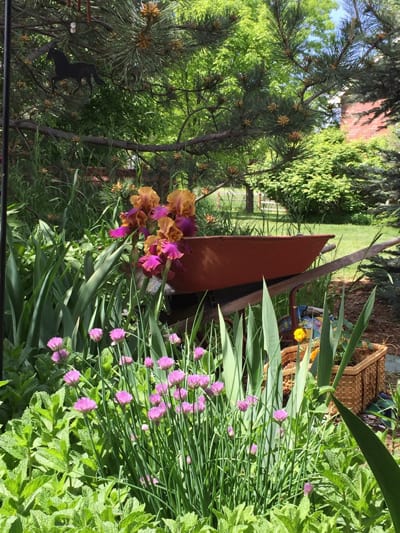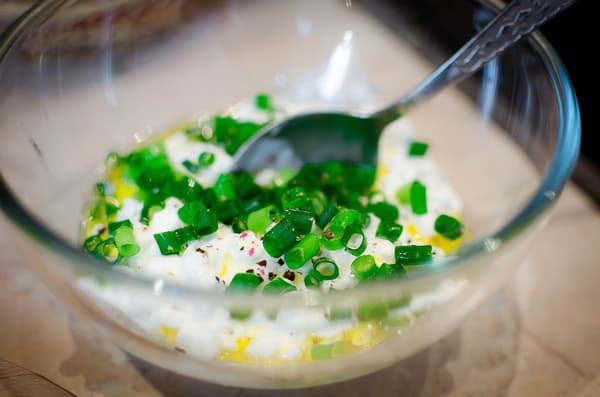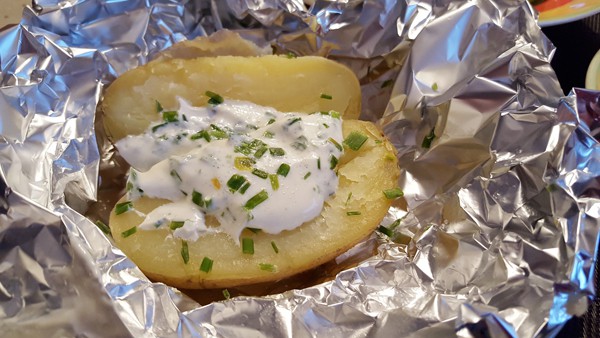In and of themselves, herbs may not be power-packed with nutrition, but there are still reasons why we should include them in our quest for quality food and better health. Herbs slow down the cooking process and connect us to nature, but besides the enjoyment of growing and cooking herbs, they impart flavor that makes food taste delicious naturally. And when we enjoy our food, smaller food servings are more satisfying.
Chives
One of the most exciting things about spring to me, besides watching gold finches at the feeders, is the sprouting of the first green shoots of the season. I’m always amazed that the first (or certainly one of the first) green shoots to appear are the garlic chives in the large clay pot by my backdoor and in my “secret garden” by the horse pen. They must be hardy. How else could they brave the cold spring nights and heavy, wet snows? Yes, chives are easy, even for a sometimes-gardener, but I’ve learned a few things about growing and eating this delectable treat that I’d like to share.
 Growing Chives
Growing Chives
Because chives are not easily found in grocery stores yet are amazingly easy to cultivate, your best source for them is your own backyard. They grow from small bulbs and do well in an outside pot, on the kitchen windowsill, in the potager (kitchen garden), in raised beds and flowerbeds, or just about anywhere. Chives come back year after year. You can plant, harvest, and enjoy them for three seasons. And with their graceful spray of greenery and beautiful purple blossoms, they create beauty in the garden.
Like any edible, the main thing to remember about growing chives is that they’re only as nutritious as the soil you plant them in. So think organic, and think compost for nutrients. As anyone who studies nutrition is aware, healthy soil means healthy food—and this leads to human health. No one understood this better in the 20th century than Dr. Royal Lee. (See his book From Soil to Supplement for a self-guided course on human nutrition that will help you understand the connection between our soil, our food and our health. Empty Harvest: Understanding the Link between Our Food, Our Immunity, and Our Planet by Dr. Bernard Jensen and Mark Anderson is another great reference on how the health of our planet directly affects our own health.)
Chives (Allium schoenoprasum) belong to the same botanical family of vegetables and herbs as garlic, onions, leeks, and scallions. They’ve been cultivated for centuries for both their pungent flavor and their medicinal properties.
Health Benefits of Chives
Chives have a long history of culinary and medicinal uses. In the Middle Ages, chives were promoted as a medicinal cure for melancholy, and some believed they drove away evil spirits. Today we know that chives and chive flowers are high in vitamin C, folic acid, and potassium. You can use them in your recipes to help restore vital nutrients lost in cooking. The high concentration of sulfur compounds and other essential oils in chives accounts not only for their healing properties but also for their tangy, aromatic taste.
 No, chives are not a power food. But they do pack a powerful, pungent flavor to many dishes, especially the new shoots of spring. Their beautiful flowers also make a brief appearance for a few weeks each spring. And chives do contain important vitamins and minerals, specifically A, C, and K, plus calcium, magnesium, folate, and choline. Numerous sources online tout chives’ properties in supporting heart health, bone strength, digestion, and the immune system. And they’re low in calories, though of course we generally don’t eat many of them anyway.
No, chives are not a power food. But they do pack a powerful, pungent flavor to many dishes, especially the new shoots of spring. Their beautiful flowers also make a brief appearance for a few weeks each spring. And chives do contain important vitamins and minerals, specifically A, C, and K, plus calcium, magnesium, folate, and choline. Numerous sources online tout chives’ properties in supporting heart health, bone strength, digestion, and the immune system. And they’re low in calories, though of course we generally don’t eat many of them anyway.
Depending on where you live and where you plant your chives, you may still have flowering plants. The flowers on the chives that I planted in sunny locations are spent in this summer heat, but I’m still harvesting from those in shadier areas. This year I’m experimenting with freezing the flowers since they’re so short-lived (about two weeks), and they seem just fine coming out of the freezer to be sprinkled on salads or mixed into eggs.
Five Ideas for Cooking with and Eating Chives
Chives are best when you use them raw (the most nutritious way to eat many foods) or minimally cook them. Use a sharp knife for chopping to avoid bruising. (Sharp scissors can also work well.)
 Here are some of my favorite applications for chives:
Here are some of my favorite applications for chives:
- Eggs: Chop chives and sprinkle them on top of (or in) cheese omelets, scrambled eggs, quiches, and frittatas.
- Vegetable dips: Whip chives into cream or goat cheese, then spread it on celery stalks or endive leaves for a mouthwatering appetizer.
- Soups and salads: Sprinkle chives on soups or salads for garnish and zest. Crushing the flowers so the blossoms break creates beauty as well as flavor.
- Baked potatoes: Top a baked potato with chives, butter, fresh crumbled bacon, and plain, full-fat Greek yogurt for a simple, delicious meal.
- Chive butter: Whip chopped chives into room-temperature butter and refrigerate in small ramekins. (I like to use individual sized ramekins so that all of the guests at a dinner party can spread their own butter on warm, fresh bread or dollop it on top of vegetables such as broccoli or asparagus.)
Herbs in Cooking: Dietary Choices from Nature’s Supply of Seasonings and Drugs by Maria and Nikos Psilakis is an informative and inspirational resource on using chives and other herbs—complete with beautiful photographs and 255 recipes! This book can help you learn about dietary customs adopted in the Mediterranean for thousands of years, including food preparations and flavored olive oil; herbal teas and beverages; and breads, cakes, and biscuits. Along with chapters on how to harvest, dry, and store your herbs, the authors provide historical, medical, cultural, and mythological information that will spur you on to better health and nutrition!
As the book quotes Hippocrates: “If people ate correctly and ate well, there would not be any illnesses!” Known as the father of modern medicine, Hippocrates taught that food should not only be healthy but also tasty. He advised using aromatic herbs in cooking to satisfy your hunger with little food because overeating is detrimental to health.
During this warm weather harvest and outdoor cooking season, I think this book is my new bible for summer cooking. Check it out!
Photos of chives in garden by Julia McSherry
 Get self-health education, nutrition resources, and a FREE copy of A Terrible Ten: Health Foods That Ain't ebook.
Get self-health education, nutrition resources, and a FREE copy of A Terrible Ten: Health Foods That Ain't ebook.

What a wonderful article, full of gardening tips, cooking suggestions, and fun historical facts. McSherry has convinced me that the often overlooked chive deserves a more prominent place in my kitchen and in my garden.